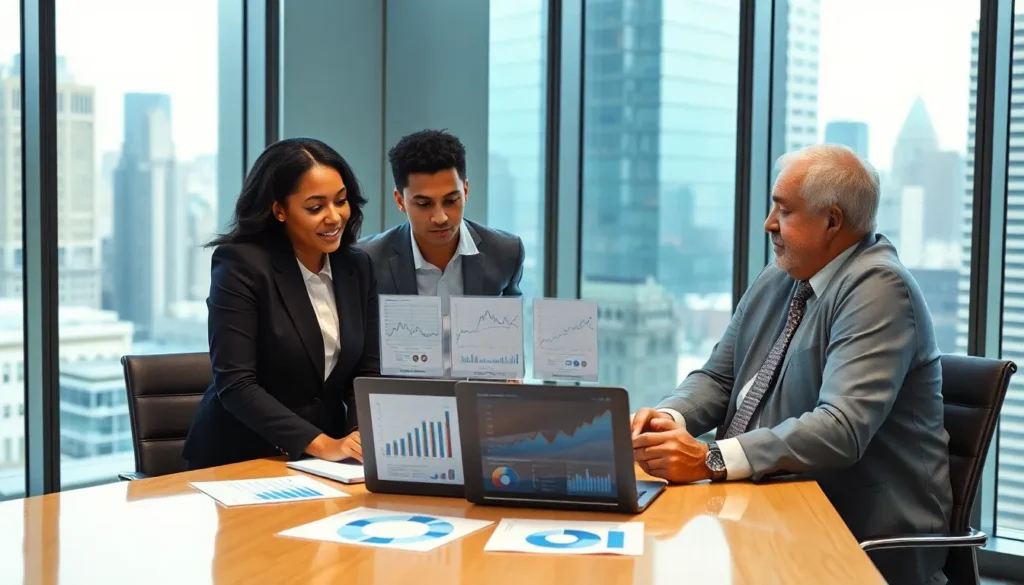Table of Contents
ToggleAs the world spins on its economic axis, keeping an eye on the financial forecast is more crucial than ever. With inflation rates dancing like nobody’s watching and interest rates playing hard to get, understanding the economic outlook can feel like deciphering a secret code. But don’t worry; it’s not rocket science—unless, of course, you’re trying to launch a startup in today’s market.
Navigating through the twists and turns of the economy can be as tricky as walking a tightrope while juggling flaming torches. Yet, staying informed can empower individuals and businesses to make savvy decisions. So buckle up and get ready to dive into the latest trends, predictions, and insights that could shape your financial future. After all, who wouldn’t want to be the one who saw the next big opportunity coming?
Overview of Economic Outlook
The current economic outlook indicates a period of uncertainty driven by fluctuating inflation rates and changing interest rates. Forecasts suggest that these elements will significantly influence consumer spending and business investments in the upcoming quarters. Analysts observe that inflation rates, currently hovering around 3.7%, impact purchasing power and overall market sentiment.
Interest rates, now at levels not seen since 2001, serve as a critical tool for the Federal Reserve in managing economic growth. Projections show that further increases might be on the horizon if inflation remains stubborn. Economic growth, shown by GDP growth rates of 2.1% last quarter, reflects a resilient economy, but underlying pressures exist.
Employment figures also provide insights. The unemployment rate stands at a low 4.0%, yet wage growth has not kept pace with inflation, squeezing household budgets. Consumer confidence fluctuates, currently measured at 103.0, demonstrating hesitance in spending habits.
Global markets face additional challenges, including supply chain disruptions and geopolitical tensions. These factors contribute to uncertainty in global trade and commodity prices. A closer look at sectors reveals technology and renewable energy as potential growth opportunities, while traditional industries may struggle with sustainability concerns.
Regional variations further complicate the economic landscape. Areas with significant manufacturing activity, like the Midwest, might experience different challenges than those focused on services or technology, such as the West Coast. Tailored strategies will be essential for individuals and businesses to navigate these economic conditions effectively.
Current Economic Indicators

Understanding the current economic indicators is crucial for assessing the financial landscape. Various metrics highlight the economy’s resilience and challenges.
GDP Growth Rate
GDP growth currently sits at 2.1%. This figure shows steady economic activity amid uncertainty. Strong consumer spending contributes significantly to this growth rate. Investments in technology and renewable energy sectors also support expansion. Despite positive numbers, underlying issues persist, such as inflation pressures that could affect future gains. As various sectors adjust, continued monitoring of GDP trends remains essential for informed decision-making.
Unemployment Trends
The unemployment rate is at 4.0%. This rate indicates a relatively healthy job market. While employment figures appear favorable, wage growth hasn’t matched inflation, causing strain on households. Job creation efforts continue, focusing on sectors like healthcare and technology. Fluctuations in consumer confidence impact hiring decisions. Understanding these trends is vital for businesses preparing to navigate potential hiring challenges.
Sector-Specific Analysis
Understanding sector-specific dynamics provides crucial insight into the economic outlook. Key areas include consumer spending and business investment.
Consumer Spending
Consumer spending reflects current economic conditions, factoring in inflation and job market stability. Presently, consumer confidence stands at 103.0, suggesting hesitance in spending habits. Households are feeling the impact of inflation at 3.7%, affecting discretionary purchases. Although GDP growth is healthy at 2.1%, continued inflation pressures could dampen future consumption. Retail sectors are adapting by innovating their offerings to attract cautious consumers. Significant variations exist among different categories, with essentials facing less resistance compared to luxury goods. Tracking these trends helps businesses tailor their strategies to maintain competitiveness in a challenging environment.
Business Investment
Business investment shows resilience amid uncertainty, particularly in technology and renewable energy sectors. Current trends indicate a focus on automation and sustainable practices. Companies are adjusting strategies to incorporate advancements in productivity and efficiency. Despite a low unemployment rate of 4.0%, wage growth has not kept pace with inflation, influencing investment decisions. Firms hesitate to expand workforce levels under these conditions but prioritize technology investments that enhance operational capabilities. Interest rates at levels not seen since 2001 add complexity to financial planning. Awareness of these investment trends is essential for stakeholders seeking growth opportunities in the evolving economic landscape.
Global Influences on Economic Outlook
Global influences play a significant role in shaping the economic outlook, impacting various sectors and consumer behaviors.
International Trade Dynamics
International trade dynamics greatly affect the economy. Current supply chain disruptions impact the availability of goods, leading to fluctuations in pricing and trade balances. Exports have seen challenges, especially in the technology sector, where component shortages persist. Imports also face delays due to logistical issues, restricting businesses from meeting consumer demand. Regional trade agreements strive to enhance market access, yet geopolitical tensions can complicate these efforts. The interplay of tariffs and trade policies continues to reshape international relationships and economic forecasts.
Geopolitical Factors
Geopolitical factors contribute to economic uncertainty. Rising tensions between major economies impact trade agreements, influencing global investment decisions. Sanctions and diplomatic disputes can disrupt supply chains, affecting commodity prices and availability. Political stability in regions rich in resources determines energy costs, which, in turn, affect inflation rates worldwide. Ongoing conflicts or strategic alliances can shift market sentiment, leading investors to reevaluate risk exposure. Awareness of these factors is essential for businesses and individuals to navigate the fluctuating economic landscape effectively.
Challenges and Opportunities Ahead
Navigating the economic landscape presents significant challenges and opportunities. Fluctuating inflation rates around 3.7% create pressure on consumer spending and household budgets. Changes in interest rates, currently at levels not experienced since 2001, further complicate financial planning for individuals and businesses.
Resilience characterizes GDP growth, measured at 2.1%. Persistent strong consumer spending, alongside investments in technology and renewable energy, indicates a forward-looking approach. Job creation remains robust in sectors like healthcare and technology, despite hiring decisions being influenced by variable consumer confidence measured at 103.0. Fluctuations in consumer confidence suggest hesitance in spending habits.
Retail sectors are becoming increasingly adaptive in response to consumer behavior. Essential goods might withstand economic headwinds, whereas luxury items are facing challenges. Businesses are focusing investments on automation and sustainable practices, particularly within the technology and renewable sectors, as a strategy to counteract economic uncertainties.
On a global scale, supply chain disruptions and geopolitical tensions pose risks to trade dynamics. Uncertainty around commodity prices remains a concern. Markets that rely heavily on international trade must remain alert to these emerging trends to maintain competitiveness in the evolving economy.
Local variations add complexity to economic assessments. Tailored strategies represent a critical approach for navigating unique regional challenges. Stakeholders who stay informed will find potential growth opportunities alongside the dynamic shifts affecting traditional industries. Keeping ahead of these changes can foster a more adept response to the unpredictable economic environment.
The current economic landscape presents a complex mix of challenges and opportunities. With inflation and interest rates fluctuating it’s crucial for individuals and businesses to remain vigilant. The resilience seen in GDP growth and strong consumer spending indicates potential for future advancements.
However the pressures from wage growth lagging behind inflation and global disruptions can’t be overlooked. Adapting strategies to navigate these uncertainties is essential for success. By focusing on sectors like technology and renewable energy stakeholders can better position themselves to thrive in this evolving environment. Staying informed and agile will be key to making wise financial decisions in the months ahead.




